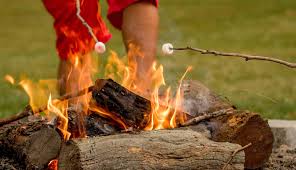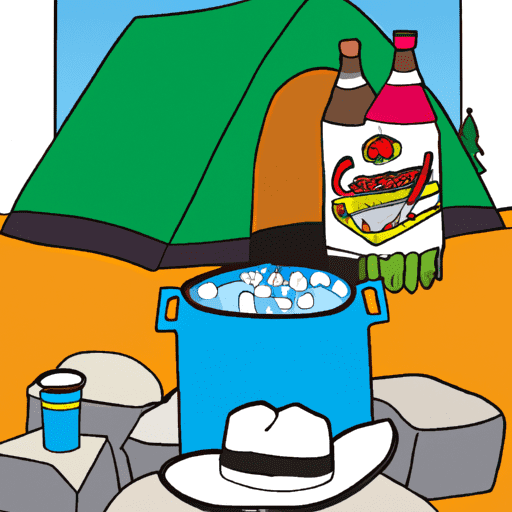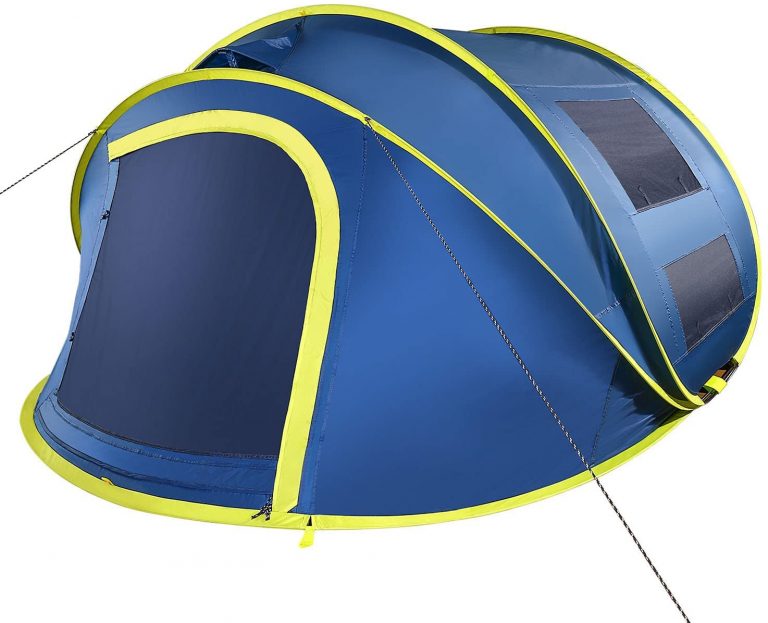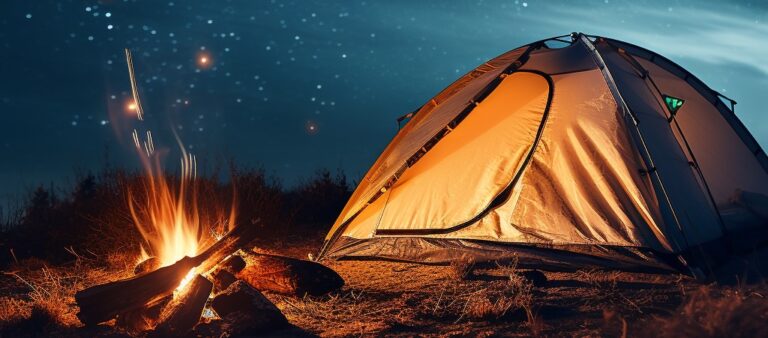You're stuck in the wilderness with only wet wood around and a desperate need for fire. Don't panic! This guide will teach you how to start a fire, even with damp logs.
We'll cover everything from selecting the best firewood to advanced fire-building techniques. So ready your patience, because although it's not easy, it's definitely possible—and we're here to show you how.
Key Takeaways
- Collect dry tinder materials such as pine needles, grass, moss, bark, wood chips, or wood shavings. If these are wet or unavailable, use cotton balls, dryer lint, crumpled paper, or toilet paper. Consider adding cooking oil or petrol to make a DIY fire starter in wet conditions.
- Look for small twigs and sticks in fallen or standing dead trees, and search the underbrush or areas where twigs and sticks were shielded from the rain. Shave off the outer layers of wet twigs to expose the dry center. Ideal kindling sticks should be thinner than an adult finger and around 6 inches long. Use a hatchet to split large logs open and shave off dry pieces for kindling.
- Use a hatchet or ax to break wet firewood into smaller pieces and make several cuts into the sides of the wood to expose more dry wood and increase surface area. In a pinch, lay a knife perpendicular to the log and baton it through to split the wood.
- Build a small mound or platform with logs or rocks to elevate the fire off the wet ground. Clear any wet debris from the fire pit before filling it with logs or rocks. The elevated platform allows the ground to dry out without extinguishing the fire and improves airflow to aid in starting a fire with wet wood.
Also see this video:
Understanding the Basics of Fire-Building
Before you can start a fire with wet wood, it's essential that you understand the basics of fire-building. This includes gathering tinder and kindling, and creating a platform for your fire.
First off, collect materials for tinder like dry pine needles or cotton balls soaked in petroleum jelly. Then gather kindling – small dead twigs or shavings from larger pieces of wood. Remember to shave off the wet outer layer to reveal the dry inside.
Once you've got your tinder and kindling ready, construct a platform out of rocks or logs to keep your fire off the damp ground. This not only prevents your fire from getting extinguished but also aids in better airflow, which is crucial when dealing with wet wood.
How to Select the Best Firewood
It's crucial to know how to pick the best firewood for your needs, considering factors such as dryness and wood type. When you're in the great outdoors, never underestimate the importance of choosing the right kindling.
- Hardwoods like oak or hickory burn longer and hotter. They're perfect if you want a cozy, long-lasting fire.
- Softwoods like pine or fir catch easily but burn faster, ideal for quick fires.
- Always opt for dry wood. It burns more efficiently than wet or green wood which can be smoky and tough to ignite.
- Remember that dead standing trees are often drier than fallen ones.
Each choice you make impacts not just your campfire experience but also your safety. So choose wisely!

Gathering Materials for Fire Starting
You'll need to gather the right materials for igniting a flame, such as dry tinder and kindling. Look for small twigs, leaves, or bark that are dry. If you can't find any, consider using alternative materials like cotton balls or paper.
For kindling, choose sticks that are thicker than your thumb but no longer than your forearm. It's crucial they're bone-dry; if wet on the outside, try shaving off the outer layer to expose the dry inner wood.
In wet conditions, building a fire platform is key. Use larger logs to elevate your fire off damp ground and ensure better airflow.
Once you've arranged your tinder and kindling on this platform, use matches or a lighter to ignite it, starting with the smallest materials first.
Preparing the Firewood for Lighting
After gathering your materials, you'll need to properly prepare the firewood for lighting. This involves ensuring it's adequately dry and split into manageable pieces. If the wood is wet on the outside, don't despair. You can often find dry wood inside larger logs. Use a hatchet or heavy knife to split the log open and expose the dry interior.
- Crack open those logs: It's like unwrapping a present, revealing the dry gift inside.
- Shave off wet bark: Imagine yourself as an artist sculpting away excess material.
- Create kindling: Feel the satisfaction of turning unusable wood into small, burnable pieces.
- Revel in preparation: The anticipation building up only adds to your eventual success.
Constructing a Fire Platform
Building a platform for your blaze is crucial, especially when conditions aren't ideal. Start by clearing the camp site and stacking dry rocks or wood to create an elevated surface. This keeps the fire off damp ground, improving airflow and ignition chances. Use logs if available; they'll serve as additional fuel once dried out.
Next, layer your kindling on this base, positioning twigs in a crisscross pattern to enhance oxygen flow. Add larger sticks gradually until you've built a sturdy pyramid. Ensure you've got enough dry tinder at hand – it's your fire's starting point.
Remember that patience is key when dealing with wet wood; it might take longer than expected to catch fire but keep feeding it patiently and watch your efforts pay off!
Techniques for Creating Dry Tinder and Kindling
In conditions where everything's soaked, it's crucial to know how to make dry tinder and kindling. While this might feel like a daunting task, it's entirely achievable with the right know-how.
Firstly, you've got to go on a hunt for dry wood. Look under piles of leaves or inside logs; nature often provides little shelters where dry wood hides. Once found, work on exposing the dry innards by removing any damp outer layers. This can be achieved by either shaving off the wet bark or splitting the wood into thin pieces.
Feel that thrill as you uncover dry wood in an otherwise wet environment.
Experience relief when your efforts pay off.
Savor the triumph of igniting your first spark.
Enjoy the warmth from your self-made fire, a beacon of hope against damp surroundings.
Remember: perseverance is key. Don't let initial setbacks douse your spirits!
Setting up Your Fire Structure
You're ready to step it up and construct your fire structure, a crucial part of getting that blaze roaring. Start by laying the kindling in a criss-cross pattern on top of your platform. This allows for better airflow, helping the fire to breathe.
Next, add larger pieces of wood in the same pattern, creating layers within your structure. Remember, wet wood will smoke more than dry wood so be prepared for this.
Now it's time to ignite your tinder. Position it under your structure where it can catch the kindling alight. Once you see flames licking through the kindling and reaching towards the logs, continue feeding small amounts of additional tinder until those larger pieces are well lit.
Patience is key here; give nature a chance to do its thing and you'll soon have a hearty fire burning.
Properly Igniting the Tinder
Properly igniting the tinder is a crucial step, and it's essential that you're patient during this process. Your key goal is to produce a sustainable flame from your chosen tinder, so don't rush.
Here are some steps to follow:
- Choose your ignition source carefully; matches or lighters often work best.
- Gently apply the flame to your tinder bundle, avoiding any sudden movements which could extinguish the flame.
- As the tinder begins to smolder, gently blow on it to help oxygenate and fuel the fire.
- Once a steady flame is achieved, carefully add your smallest pieces of kindling.
Tips for Maintaining Your Fire
Alright, now that you've successfully ignited your tinder and have a fire going, let's focus on how to maintain it.
First off, don't leave the fire unattended. It requires constant attention and nourishment to keep burning, especially in wet conditions.
Keep adding small twigs or sticks gradually as they start drying out from the heat of the fire. Remember, wet wood smokes a lot; this is normal. To reduce excessive smoking and improve burning efficiency, try splitting bigger logs into smaller pieces before adding them to the fire.
Also make sure there's sufficient ventilation for improved airflow around your setup.
Lastly, remember safety first! Always have water or sand handy to put out your fire when done or in case of emergency.
Dealing With Challenges of Wet Wood
Dealing with damp logs can be quite a challenge, but it's not impossible if you know the right techniques.
First, get your hands on the driest wood available. If everything seems wet, don't despair! Here are some strategies to employ:
- Split open large logs: The inside is likely drier.
- Scrape off wet bark: Underneath it might be dry wood.
- Use resin-rich woods: They burn better even when damp.
- Employ accelerants: Certain chemicals or household items can help ignition.
Safety Precautions for Fire-Building
It's essential to remember that safety precautions must always be taken when building a fire, even in challenging conditions. Always clear the area around your intended fire site of flammable materials, and never leave a fire unattended. In wet conditions, ensure you have adequate tinder and kindling before starting your fire.
Here are some key considerations for safe fire-building:
Safety PrecautionsImportanceClear AreaPrevents accidental spread of flames to nearby flammable materialsNever Leave UnattendedFire can quickly get out of control if not monitoredAdequate Tinder/KindlingEnsures quick ignition and reduces time spent trying to ignite damp woodProper ExtinguishingPrevents smoldering embers from reigniting
Remember these steps as you build a fire under any circumstances; safety should always be your priority.
Preserving Your Fire in Changing Weather Conditions
In fluctuating weather conditions, it's crucial to preserve your fire by using the right materials and techniques. To start a fire with wet wood, you need to be tactful and patient.
First, gather your materials: search for dry tinder like moss or bark. If these are damp or non-existent, use cotton balls soaked in cooking oil.
Next, prepare your kindling. Look for small twigs and sticks, preferably from fallen trees.
Thirdly, create a platform from logs or rocks to lift the fire off the wet ground.
Finally, ignite your fire carefully and tend to it regularly by adding more logs as needed.
Remember – perseverance is key when trying to maintain a fire with wet wood.
Efficient Use of Fire Starters
You'll find that efficient use of fire starters can make a huge difference in how quickly you're able to get your blaze going.
When using wet wood, it's crucial to have a reliable fire starter. Choose from commercially available ones like magnesium fire starters, or make your own with items like cotton balls soaked in petroleum jelly.
To use, ignite the fire starter and place it under your kindling structure. The intense heat will dry out and ignite the kindling above it.
Remember, preparation is key; ensure you've gathered enough tinder and kindling before lighting your fire starter.
Lastly, always keep spare fire starters in a waterproof container for emergencies.
Proper use of these tools can turn a daunting task into a manageable one!
Beneficial Tools for Fire-Building
Having the right tools can significantly boost your fire-building skills, especially in challenging conditions. A key tool is a good fire starter. Some examples include matches or lighters. These are simple, yet effective and quick at getting the job done.
Another useful tool is a fire steel. This reliable tool can produce sparks even when it's wet. Additionally, magnesium blocks work similarly to fire steels but burn hotter, helping ignite damp tinder.
In addition to a fire starter, you'll also need a dependable knife for preparing your kindling and shaving off wet bark from wood. This tool is essential for making sure you have the right materials to start your fire.
Lastly, you might consider a hatchet or small axe for splitting larger logs. This tool can be helpful if you need to break down bigger pieces of wood for your fire.
With these tools in hand, you're well-equipped to start a fire with wet wood. Stay warm!
Practical Solutions for Wet Wood Situations
When you're faced with damp conditions, there are practical solutions that can help you overcome the challenge of lighting a fire.
Start by gathering dry tinder and kindling. Look under fallen trees or dead wood piles to find dry materials, shaving off any wet outer layers. Splitting larger pieces of wood may also expose dry interiors.
Once your materials are ready, build a platform using logs or rocks to keep the fire elevated from the wet ground and improve airflow.
Light your tinder in the middle of this platform and gradually add your kindling and larger pieces of wood, arranged for optimum ventilation.
Additional Resources for Fire-Building
It's helpful to reference additional resources for fire-building techniques and safety. When you're out in the wilderness, faced with damp wood and the need for a warm fire, having this knowledge can be the difference between comfort and discomfort, or even survival.
Here are some resources that could help:
- Wilderness Survival Guide: This comprehensive guide details various fire-starting methods in different conditions.
- Backpacker Magazine's Fire Skills: An informative article filled with practical tips and tricks.
- OutdoorLife.com: Offers numerous articles on outdoor survival skills, including fire starting.
- SurvivalistBoards.com: A forum where experienced outdoors people share their wisdom.
Advanced Techniques for Fire-Building
Advanced techniques for building a blaze can be crucial in challenging environments and conditions. It's essential to understand how to construct a fire lay, select the right wood, and use effective tools.
For instance, a lean-to or A-frame fire lay is ideal for wet wood fires. These structures create a protective roof over your dry tinder and kindling, shielding them from rain.
Fire Lay TechniquesDescriptionLean-ToThe structure leans against an upright log with the flame protected underneathA-FrameTwo logs are placed parallel with kindling arranged in an ‘A' shape on top
Learning From Common Fire-Building Mistakes
Learning from common mistakes in fire-building can drastically improve your skills and efficiency. One of the most common errors is neglecting preparation. Remember, failing to prepare is preparing to fail.
- You may rush into lighting the fire without gathering enough wood or preparing a proper fire pit. This could lead to a quickly extinguished flame or an uncontrollable blaze.
- Another mistake is using inappropriate or damp materials for tinder, resulting in difficulty igniting the fire.
- Ignoring safety precautions like keeping water nearby, controlling the size of your flame, and ensuring it's fully extinguished when you're done are crucial missteps that can lead to dangerous situations.
Avoid these pitfalls for a safer and more efficient experience next time you build a fire with wet wood.
Popular Questions
What Are Some Common Mistakes Beginners Make When Trying to Start a Fire With Wet Wood?
Common mistakes include not gathering enough dry tinder, failing to create a platform for your fire, and neglecting to expose the dry inside of wet wood. You'll also want to avoid using green wood.
Can You Start a Fire With Wet Wood Without Using Any Fire Starters?
Yes, you can start a fire with wet wood without fire starters. You'll need to find dry tinder, create a platform, expose the dry wood within your logs, and gradually build and maintain your fire.
What Are Some Effective Ways to Dry Out Wet Wood in the Wilderness?
To dry out wet wood in the wilderness, split it open to expose the drier inside. It's also effective to build a fire with any available dry wood and place the wet pieces near it to dry.
How Can You Tell if the Inside of a Log Is Too Wet to Burn?
Split the log open to check. If it's damp or darker in the middle, it's too wet. Wet wood can also feel heavier than dry wood. Remember, burning wet wood produces more smoke and less heat.
Are There Any Types of Wood That Are Easier to Light When Wet Compared to Others?
Yes, certain woods like pine and cedar ignite easier when wet due to their high resin content. Resin can act as a natural firelighter, aiding in starting fires even with damp wood conditions.
Conclusion
In conclusion, starting a fire with wet wood isn't as tough as you might think. With the right materials and techniques, you can overcome this challenge.
Remember to gather plenty of dry tinder and kindling, prepare your firewood properly, and build a sturdy platform.
Patience is key – wet wood will smoke more and may need frequent tending. Always prioritize safety when building any fire.
Keep learning and experimenting with different methods to become proficient in this useful skill.







